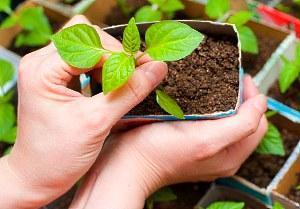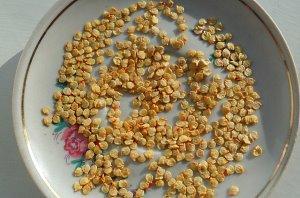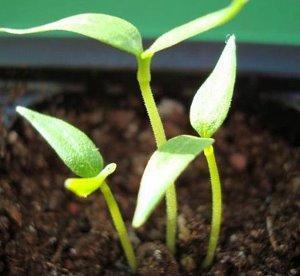Growing pepper in the open field and greenhouse
 One of the most common crops grown by almost every summer resident is sweet pepper. And there are several reasons for universal love:
One of the most common crops grown by almost every summer resident is sweet pepper. And there are several reasons for universal love:
- At firstThis tasty and healthy vegetable is versatile. It can be cut into fresh salads, or even prepared as a separate dish.
- Secondly, pepper is easy and simple to grow if you know a few basic principles of how to do it right.
In order for a culture to feel comfortable, you need to look a little into history. This will help you find out what conditions are necessary for good fruiting, both in the open field and in the greenhouse.
The homeland of sweet pepper is South America. This means that this plant is best suited for approximately the same climate: warm and not arid.
If it's still cool in the greenhouse, install a heater. And remove excess moisture by airing.
Open ground pleases the plant with warmth, but for good growth it is necessary watering... These are the basic rules. But there are subtleties of pepper care that every summer resident should know.
How to grow a good harvest of peppers outdoors?
A good harvest of peppers is no coincidence. It takes effort with knowledge. So, for example, the rate of ripening of the fruit and the peculiarities of caring for it will depend on the choice of the variety. The time of sowing the seeds and the time of planting a young plant in the ground will depend on the variety.
Let's divide the whole process of growing pepper into several stages:
- Soil and seed preparation.
- Growing pepper seedlings from seeds.
- Plant care.
- Diseases and pests.
First step

- One of them is to soak the seeds in hot water (water temperature from 40 degrees and above) for 4-6 hours. After that, the seeds are placed in a damp cloth in a heated room for 2 days.
- Another way is to dress the seeds in a weak solution of potassium permanganate for 15-20 minutes. Then they must be rinsed and placed in a solution. growth promoter for 12 hours. After that, the seeds are washed and placed in a damp cloth for a couple of days.
- Land preparation. If ready-made soil is sold for sowing seeds. Then for planting seedlings after a pick and for growing peppers in the open field, you need to take care that the earth is loose and light, well fertilized... To do this, add humus and sand to the soil, in a ratio of 2 to 1. You can add ash.
- Soil preparation also includes site selection. This should be a bright place, protected from drafts. It is advisable to fertilize the ground in the fall superphosphate (40-50 g), rotted manure (about 10 kg) and wood ash (up to 100 g). These figures are per 1m² of soil.
Second phase
 Considering that pepper seeds germinate for a long time, within two weeks, they should be planted in advance in a container in order to first grow seedlings.
Considering that pepper seeds germinate for a long time, within two weeks, they should be planted in advance in a container in order to first grow seedlings.
The approximate dates when it is better to do this is the end of January, the beginning of February, depending on the variety and where young plants will be planted: in open or closed ground.
Sowing seeds:
- the soil is pre-treated with a weak solution of potassium permanganate;
- the box should be at the bottom with holes;
- the distance between the seeds is 2 cm;
- after disembarking, cover the box with foil or glass, put it in a dark, warm place;
- the box is put into the light with the appearance of the first shoots;
- water only when the soil dries out;
- pour with lukewarm water;
- dive with the appearance of two true leaves.
You can sow pepper seeds in separate pots, then you don't have to transplant it, which the plant will really like.
Stage three
About 100 days pass, and the seedlings are ready for relocation to a permanent residence. Mid or late May is great for this. The soil then warms up well, and the plant is less sick. If the climate for heat-loving peppers is not quite suitable, this problem can be easily solved by building a plant high beds.

The seedlings themselves, and the beds for pepper prepared by that time, should be watered abundantly. The water must be warm! The distance between bushes and beds should not be less than 40-60 cm.
What does it take to take proper care of your plants? There is a simple rule of four "Ps":
- Top dressing.
- Watering.
- Weeding.
- Garter.
Here are some tips for caring for peppers:
- Top dressing. During the growth and development of the plant (growing season), the pepper must be fed 3-4 times. This can be done both with specially prepared commercially available means, or by preparing the fertilizer yourself.
- For the first time, seedlings are fed 10-14 days after planting in open ground. For 10-12 liters of water, 1 liter of manure is taken.
- Second dressing before flowering. Potassium humate is diluted with 10 liters of water, 2 tbsp is added. double superphosphate (it can be pre-crushed).
- For the third time, pepper is fed with wood ash or superphosphate (it can be combined). A glass of ash (or 2 tablespoons of superphosphate) is filled with water and infused in the sun for 2 days. This feeding is carried out two weeks after the last fertilization of the plants.
Nettle is an excellent universal fertilizer. Cut the nettles, put them in a bucket and pour 1 to 10 warm water. Insist for 2 or 3 days. Fertilizer is ready.
- Watering. This plant loves moisture, but not waterlogging. Therefore, it is worth watering the pepper only if the soil is dry. The water must be warm!
- Weeding. Light, fluffy soil is a prerequisite for good pepper growth. To do this, the land must be plowed up regularly.
- Garter. Not only high varieties of peppers need support, but also those that delight gardeners with a good harvest. To do this, so as not to injure the roots of the plant later, even when planting seedlings, a support is buried next to the bush.
Pepper care when problems arise
Diseases and pests that harm pepper:
- late blight;
- blackleg;
- white rot;
- black bacterial spot;
- aphid;
- whitefly;
- bear;
- slugs;
- Colorado beetle.
If the "black leg" is easy to prevent, using good soil, avoiding waterlogging, and watering it only with warm water, then from such a disease as late blight, the most effective method will be prevention. For this, it was necessary to dress the seeds before planting. And with the arrival of night coolness and rains, plants should be covered at night. Spraying with onion husk infusion is also useful.
For insects such as the Colorado potato beetle and the bear, experienced summer residents use special preparations and herbal infusions: tansy, garlic, yarrow, wormwood.
Pollination with wood ash will help to protect the plant from pests. Aphids can be defeated with serum mixed with water (1.5 liters per bucket of water).
Tips for growing peppers in a greenhouse
Many summer residents prefer to grow heat-loving peppers in a greenhouse. But here, too, there are some points that you need to know and be prepared for. For instance:
- In order for the cultivation of pepper in a greenhouse to bring only positive results, you need to carefully consider the choice of variety. Not every variety of pepper can do insect-free pollination. But even in this case, you can try artificial pollination using an ordinary soft brush.
- Usually the soil in greenhouses is depleted from more frequent use.So, you need to take care of fertilizing it or replacing the top layer (20-25 cm) of the soil.
- Pesticides and fertilizers are best used those that are suitable for greenhouses. Most often, their packaging has a special mark.
- To control pests that find comfortable conditions in the greenhouse, it is necessary to spray pepper with Fitosporin once a month.
- If the pepper is planted in the greenhouse in spring or autumn, then it is best to warm up the air in it.
- It is imperative to ventilate the greenhouse to avoid too high temperatures and high (almost 100%) humidity. If you cannot regularly ventilate the greenhouse, you can equip it with artificial ventilation.
Having learned how to properly grow peppers in a greenhouse, and taking the necessary actions, you can ensure that the plants are healthy and the yields are high.

Seedlings for greenhouses and for open field are grown according to the same principles. Three points are essential for this: pots with plants you need to keep warm; make sure that the earth does not dry out and is not too wet; the soil should be lush and light. Sand, humus, undecomposed organic matter give the soil looseness.
You can start transplanting seedlings into the greenhouse earlier than into open ground. At the same time, experienced summer residents advise to do this carefully so that the roots of the young bush are completely immersed in the planting hole, without bending or twisting.
There are few rules for growing pepper in the open field, they are all easy to follow. If you follow them, you can get an excellent harvest.

Here are some helpful tips for growing peppers productively outdoors:
- To attract insects during flowering, the plant can be sprayed with sweetened water.
- Pepper is easily pollinated. Therefore, you should not plant different varieties of it close to each other.
- The plot that is planned to be given for pepper is carefully selected. In order to avoid plant diseases and for a good harvest, in no case should the representatives of table root crops, pumpkin and legumes be the predecessors of pepper.
- It is imperative to harden the plant for their better acclimatization. To do this, 10 days before planting in open ground, it is necessary to take out the seedlings to fresh air. Starting from 10-15 minutes, you need to gradually increase the residence time of the plants.
- If frost hits unexpectedly, the pepper plants can be saved. To do this, you need to water the soil well. Or insulate the plants with foil, paper, lutrasil. You can put plastic bottles with a cut off bottom on the bushes.
Over time, each summer resident gains his own experience. This helps him to expend less energy for good results.
Read also: when to sow peppers for seedlings?